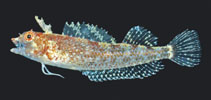| Family: |
Tripterygiidae (Triplefin blennies), subfamily: Tripterygiinae |
| Max. size: |
4.5 cm SL (male/unsexed) |
| Environment: |
benthopelagic; marine; depth range 5 - 80 m, non-migratory |
| Distribution: |
Eastern Indian Ocean: northern Tasmania to Port Phillip Bay, Victoria. Endemic to the Bass Strait area in southern Australia. |
| Diagnosis: |
Dorsal spines (total): 16-17; Dorsal soft rays (total): 10-12; Anal spines: 2-2; Anal soft rays: 19-22. 22-26 pored scales in the anterior lateral line series; 0-13 notched scales in the posterior series. The second dorsal fin without an ocellate black blotch but may be distally blackish, the anal fin pale, occasionally with whitish spots; the pelvic fin pale, and the dorsal fine spines each with two large distal spinules. |
| Biology: |
Associated with yellow sponges. Eggs are hemispherical and covered with numerous sticky threads that anchor them in the algae on the nesting sites (Ref. 240). Larvae are planktonic which occur primarily in shallow, nearshore waters (Ref. 94114). |
| IUCN Red List Status: |
Least Concern (LC); Date assessed: 03 May 2010 Ref. (130435)
|
| Threat to humans: |
harmless |
Source and more info: www.fishbase.org. For personal, classroom, and other internal use only. Not for publication.
